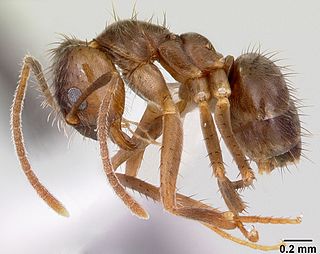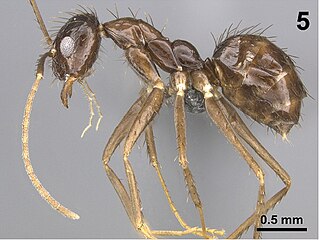Related Research Articles

The yellow crazy ant(Anoplolepis gracilipes) is a species of ant, originally from Southeast Asia, that has been accidentally introduced to numerous places in the world's tropics.

Myrmecophilus or ant crickets, is a genus of orthopteran insects in the family Myrmecophilidae. This genus contains the majority of myrmecophilous (ant-loving) species in this small, obscure family.

The Myrmecophilidae or ant-loving crickets are rarely encountered relatives of mole crickets, and are obligate inquilines within ant nests. They are very small, wingless, and flattened, so resemble small cockroach nymphs. The few genera contain fewer than 100 species. Ant crickets are yellow, brown, or nearly black in color. They do not produce sound, and lack both wings and tympanal organs ("ears") on the front tibia.

Paratrechina is one of seven ant genera in the Prenolepis genus-group from the subfamily Formicinae. Six species are included in Paratrechina; one of which, the longhorn crazy ant, is a widespread, pantropical pest.

Myrmecophilus acervorum is an orthopteran insect belonging to the family Myrmecophilidae. This continental European species is probably the most widespread and most frequently encountered member of this rather obscure family found in Europe. It is also by far the smallest orthopteran found in Western Europe, with its total adult length never exceeding 3.5 mm (0.14 in).

The tawny crazy ant or Rasberry crazy ant, Nylanderia fulva, is an ant originating from South America. Like the longhorn crazy ant, this species is called "crazy ant" because of its quick, unpredictable movements. It is sometimes called the "Rasberry crazy ant" in Texas after the exterminator Tom Rasberry, who noticed that the ants were increasing in numbers in 2002. Scientists have reorganised the genera taxonomy within this clade of ants, and now it is identified as Nylanderia fulva.

Nylanderia pubens is a species of ant of the genus Nylanderia, commonly called the Caribbean crazy ant. It was originally described as Paratrechina pubens from Saint Vincent, Lesser Antilles. This species was moved from Paratrechina to the genus Nylanderia in 2010.

The longhorn crazy ant, also known as "black crazy ant", is a species of small, dark-coloured insect in the family Formicidae. These ants are commonly called "crazy ants" because instead of following straight lines, they dash around erratically. They have a broad distribution, including much of the tropics and subtropics, and are also found in buildings in more temperate regions, making them one of the most widespread ant species in the world. This species, as well as all others in the ant subfamily Formicinae, cannot sting.

Nylanderia is a large genus of ants in the subfamily Formicinae. The genus has a nearly cosmopolitan distribution with species inhabiting a wide array of habitats in almost all geographic regions. Nylanderia, currently containing over 110 species, is an ecologically important genus, with some species reported as being invasive. The ants are small to medium in size and range in color from pale yellow to black.

Paratrechina zanjensis is an African species of ant in the genus Paratrechina. It is one of two species in the genus, the other being the longhorn crazy ant.
Macrodinychus multispinosus is a mite that lives as an ectoparasitoid on the invasive Paratrechina longicornis. These mites complete their development on a single host, sucking all of its body content and therefore killing it. This is the ninth species of Macrodinychus reported as ant parasite, and the third known as parasitoid of invasive ants, confirming a unique habit in the evolution of mite feeding strategies and suggesting that the entire genus might be parasitic on ants.
Myrmecophilus manni is a species in the family Myrmecophilidae, in the order Orthoptera. Common names are "desert ant cricket" and "Mann's ant cricket". Myrmecophilus manni is found in North America.
Myrmecophilus pergandei, the eastern ant cricket, is a species of ant cricket in the family Myrmecophilidae. It is found in North America.
Myrmecophilus nebrascensis, the Nebraska ant cricket, is a species of ant cricket in the family Myrmecophilidae. It is found in North America.
Myrmecophilus oregonensis, known generally as the Oregon ant cricket or west coast ant cricket, is a species of ant cricket in the family Myrmecophilidae. It is found in North America.